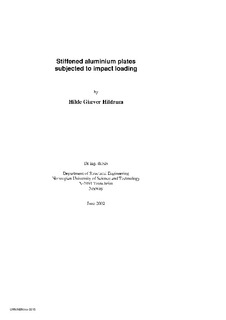| dc.contributor.author | Hildrum, Hilde Giæver | nb_NO |
| dc.date.accessioned | 2014-12-19T11:24:29Z | |
| dc.date.available | 2014-12-19T11:24:29Z | |
| dc.date.created | 2002-08-15 | nb_NO |
| dc.date.issued | 2002 | nb_NO |
| dc.identifier | 121999 | nb_NO |
| dc.identifier.isbn | 82-471-5467-6 | nb_NO |
| dc.identifier.uri | http://hdl.handle.net/11250/231145 | |
| dc.description.abstract | An experimental investigation has been carried out to study the behaviour of stiffened aluminium plates subjected to large mass (55 kg) projectiles in the low velocity regime. The stiffened aluminium plates were fabricated from aluminium alloy AA6082 temper T6 extrusions MIG-welded together to form flat stiffened plates. The study was made on the variation of failure mode and the energy-absorbing capacity with various combinations of projectile nose shape (blunt and hemispherical) and load application point (between two stiffeners, on a stiffener and next to a stiffener).
The estimated incipient fracture velocity (giving cracks in the target) was significant less for the hemispherical ended nose than the blunt ended nose. The impact between the stiffeners gave lowest incipient fracture velocity followed by impact next to the stiffener and impact on a stiffener in that order. The estimated ballistic limit velocity was almost equal for impact between two stiffeners using both nose shapes and for impact next to a stiffener with the blunt ended projectile. The hemispherical ended projectile impacting next to a stiffener lead to significant higher ballistic limit.
The observed differences in the ballistic limit velocity and incipient fracture velocity were mainly attributed to the change in failure mode (and energy absorption). The blunt projectile caused failure by plugging, while petaling fracture modes were observed for impact with a hemispherical ended projectile.
In addition to impact tests, static punch tests were carries out to study any possible relationships between the dynamic and quasi-static capacity before fracture occurs. In the studied velocity range and for the blunt ended projectile, it seems that the static tests may give a conservative estimate of the incipient fracture impact energy. For the hemispherical ended projectile this method may lead to non-conservative results.
A metallurgical examination of cross sections of the target at the impact point was carried out to reveal details of internal changes of configuration such as deformations and changes of microstructure, and the generation of fractures. The fracture was initiated on the rear side impacting next to a stiffener or between the stiffeners (on the weld) with both nose shapes. Ductile fracture was observed in all test specimens except for fracture in the welds. No evidence of temperature effects and no pronounced shear localisation through the thickness of the plate where seen.
Numerical simulation of perforation of a stiffened plate impacted with a hemispherical ended projectile between two stiffeners (on the weld) has been performed using the non-linear finite element code LS-DYNA. Inverse modelling of tensile test specimens was performed to identify the material parameters. The weld and heat affected were modelled with reduced strength compared to the parent material. The main objective with these numerical simulations was to study whether the Lemaitre damage material model could predict the response of the impacted plate when taking failure into account. The numerical simulation described the maximum force quite well. Furthermore, the model predicts the instability phenomenon and fracture process as observed in the experiments reasonably well. | nb_NO |
| dc.language | eng | nb_NO |
| dc.publisher | Fakultet for ingeniørvitenskap og teknologi | nb_NO |
| dc.relation.ispartofseries | Dr. ingeniøravhandling, 0809-103X; 2002:69 | nb_NO |
| dc.title | Stiffened Aluminium Plates Subjected to Impact Loading | nb_NO |
| dc.type | Doctoral thesis | nb_NO |
| dc.source.pagenumber | 153 | nb_NO |
| dc.contributor.department | Norges teknisk-naturvitenskapelige universitet, Fakultet for ingeniørvitenskap og teknologi | nb_NO |
| dc.description.degree | dr.ing. | nb_NO |
| dc.description.degree | dr.ing. | en_GB |
